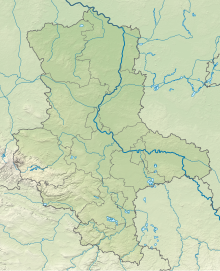Asendorfer fag
Coordinates: 51 ° 25 ′ 49 ″ N , 11 ° 43 ′ 22 ″ E
The Asendorfer Kippe is a nature reserve in the municipality of Seegebiet Mansfelder Land and in the district of Mansfeld-Südharz and in the municipality of Teutschenthal in the Saalekreis in Saxony-Anhalt .
The nature reserve with the registration number NSG 0182 is around 47 hectares in size. It has been under protection since 1998 (date of regulation: August 19, 1998). Responsible lower nature conservation authorities are the districts of Mansfeld-Südharz and Saalekreis.
The nature reserve is located east of Schraplau on the southern edge of the Amsdorf opencast mine . It places a non- recultivated overburden dump under protection as a small section of the post-mining landscape on the edge of the Asendorf open-cast lignite dump . Different volumes of waste from the opencast mine, such as tertiary sands and gravel, were dumped on the heap, so that different types of biotope have formed depending on the different surface conditions . For example, there are sometimes temporary small bodies of water and water -logged places where reeds with reeds , narrow-leaved cattails , salt pond rushes and common beach ledges have spread.
A special feature is here orchid spotted orchid . There are also pioneer sites and salt corridors. There are also riding grass fields with white ostrich and land riding grass , as well as grassland species such as bluebell , golden thistle , asparagus pea , yellow scabiosa and dry root . Some areas have been reforested with poplars and alders . In addition, are woody succession areas and arable broke with cairns to find that remain largely left to their natural development. Many silver birch , aspens and hawthorn species have settled here. After all, there are deposits of inland salt points in the nature reserve that are of particular importance. Rare halophytes such as beach millennium , winged chickweed and the salt-tolerant asparagus pea can be found here.
With its secondary biotopes, the nature reserve offers a large number of animal species a suitable habitat. So here numerous are birds before, including red-backed shrike , lapwing , gray partridge , quail , nightingale , oriole , Dunnock , corn bunting , black and Whinchat , Willow Warbler , Grasshopper Warbler , Yellow Warbler , Wheatear , Tawny Pipit , Little Ringed Plover , Sedge Warbler , Beutelmeise , Spotted Crake and Water Rail .
In addition to a rich avifauna , numerous other animals have also settled in the nature reserve. So flowery fallow areas are habitat z. Sometimes endangered wild bees , butterflies and grasshoppers . The small bodies of water offer amphibians such as green toad and common garlic toad a suitable habitat and are home to numerous dragonflies , including endangered species such as the lesser king dragonfly , the little rush damsel , the banded darter and the great darter . Moisture-loving locusts such as short-winged and long-winged swordfish can also be found here.



